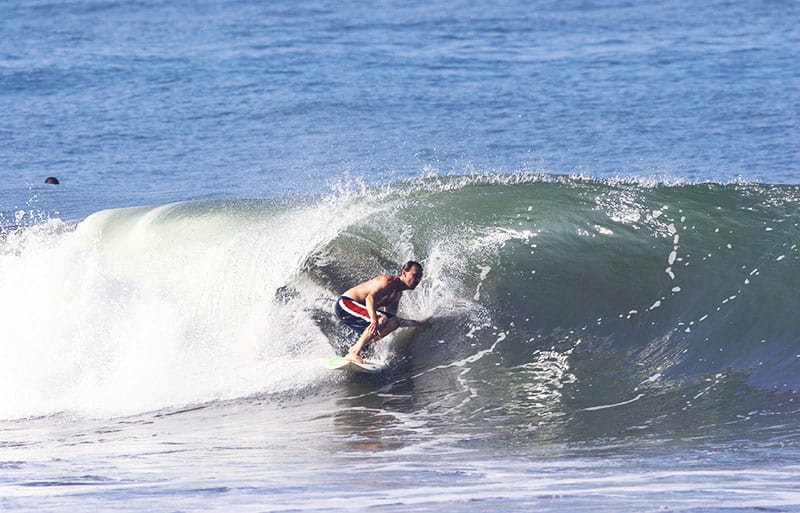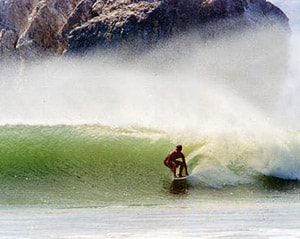
If you’re gearing up for a surfing adventure in Costa Rica, understanding the surf forecast and knowing where to find the best waves are critical steps to ensuring an unforgettable experience. Costa Rica, with its breathtaking beaches, warm waters, and world-renowned surf breaks, has solidified its status as a top-tier destination for surfers worldwide.
Whether you’re a seasoned pro chasing powerful barrels or a beginner eager to catch your first wave, this tropical paradise offers something for everyone. However, with two coastlines—the Pacific and the Caribbean—and countless surf spots to explore, planning your trip can feel overwhelming. That’s where a detailed Costa Rica Surf Map and Surf Forecast become your best tools, helping you pinpoint the perfect break based on real-time conditions and your skill level.
In this comprehensive guide, we’ll dive deep into why checking the Costa Rica Surf Forecast is a must before you wax your board, break down how to read and interpret forecast data like a pro, and spotlight some of the country’s most iconic surf spots across both coasts. From the rugged waves of the Nicoya Peninsula to the Caribbean’s tropical swells, we’ll equip you with the knowledge to maximize your time in the water. Let’s paddle in!
Why the Costa Rica Surf Forecast Matters
Costa Rica’s geography—flanked by the Pacific Ocean to the west and the Caribbean Sea to the east—creates a unique surfing playground with diverse swell patterns, wind conditions, and wave types. The Pacific coast, including hotspots like Tamarindo, Jaco, and Pavones, benefits from consistent swells generated by storms in the Southern Hemisphere and North Pacific, while the Caribbean side, home to Salsa Brava, thrives on tropical swells from the Atlantic.
However, conditions can shift dramatically day-to-day or even hour-to-hour due to local winds, tides, and seasonal changes. Without a reliable surf forecast, you might arrive at a beach expecting epic waves only to find flat seas or unrideable chop.
The Costa Rica Surf Forecast provides a wealth of data—wave height, swell direction, period, wind speed, tide times, and water temperature—to help you plan your sessions with precision. By checking the forecast ahead of time, you can decide which coast to hit, which breaks will be firing, and what gear (like board size or wetsuit thickness) to pack.
For example, a strong south swell might light up Pavones’ legendary left-hand point break, while a north swell could make Tamarindo or Nosara the place to be. Timing your trip around peak swell windows and favorable winds can mean the difference between scoring the ride of your life and sitting on the shore watching the ocean taunt you.
Beyond performance, forecasts also enhance safety. Costa Rica’s powerful waves and strong currents—like the notorious rips at Playa Hermosa or Jaco—demand respect. Knowing when conditions might exceed your skill level helps you avoid dangerous situations. Plus, with Costa Rica’s tropical climate, sudden storms or offshore winds can turn a glassy session into a chaotic one fast. A good forecast keeps you informed and prepared.
How to Read a Costa Rica Surf Forecast

View detailed surf forecast for Tamarindo. Visit surf-forecast.com for more details, long range forecasts, surf reports, swell and weather maps.
At first glance, a surf forecast might look like a jumble of numbers, arrows, and charts, but once you crack the code, it’s a treasure map to perfect waves. Here’s a breakdown of the key metrics every surfer should master:
Wave Height
Measured in feet or meters, this tells you the average size of the waves from trough to crest. For beginners, 2-4 feet is manageable and fun; intermediates might crave 4-6 feet; and advanced surfers often seek 6 feet or more for a challenge. In Costa Rica, spots like Pavones can see waves swell to 10 feet or higher during peak season, while gentler breaks like Nosara might hover around 3-5 feet.
Swell Direction
This indicates where the swell originates, shown as a compass direction (e.g., SW for southwest, N for north). Costa Rica’s Pacific coast loves south and southwest swells, which roll in from Southern Hemisphere storms, especially from May to November. North and northwest swells, common from December to April, fire up spots like Tamarindo and Playa Negra. On the Caribbean side, Salsa Brava thrives on northeast swells from Atlantic systems, peaking from December to March.
Swell Period
Measured in seconds, this is the time between wave crests passing a fixed point. Longer periods (12-16 seconds) mean bigger, more powerful waves with better shape—ideal for point breaks like Santa Teresa or Pavones. Shorter periods (6-10 seconds) produce weaker, choppier waves, better suited for beach breaks or beginners.
Wind Speed and Direction
Wind can make or break your session. Offshore winds (blowing from land to sea) groom waves into clean, glassy perfection—think early mornings at Jaco or Dominical. Onshore winds (sea to land) create messy, bumpy conditions, though they might still be rideable for less picky surfers. Check wind speed too; anything over 15 knots can turn a good day sour.
Tide
Tides dramatically affect wave shape and accessibility. Some breaks, like Playa Hermosa, fire best at mid-to-high tide, while others, like Pavones, need a lower tide to expose the reef or sandbar. Forecasts include tide charts—use them to time your sessions.
Water Temperature
Costa Rica’s waters are blissfully warm, averaging 78-84°F (25-29°C) year-round. You won’t need a full wetsuit, but a rash guard or 1-2mm shorty can protect against sun and board rash. The Pacific is slightly cooler than the Caribbean, especially in the rainy season (May-November).
With practice, you’ll blend these factors into a mental picture of the surf. Websites like Surf-Forecast.com or MagicSeaweed offer detailed reports, including long-range predictions, live webcams, and swell maps for spots like Tamarindo, Jaco, and Salsa Brava. Pair these with local knowledge—like chatting up surf shop owners or watching the lineup—and you’ll be dialed in.
Costa Rica Surf Map: Top Spots to Explore
Costa Rica’s surf map is a tapestry of beach breaks, reef breaks, and point breaks, stretching across its Pacific and Caribbean coasts. Here’s a detailed rundown of must-visit spots, tailored to different skill levels and vibes:
Pacific Coast Highlights
Tamarindo (Guanacaste)
- Vibe: Bustling surf town with a mix of beginners and pros.
- Waves: Consistent beach break with lefts and rights, best on mid-to-high tide. Swell direction: NW or SW; size: 3-8 feet.
- Why Go: Perfect for all levels, with surf schools galore and a lively nightlife. Check Surf-Forecast.com for live conditions and webcam feeds.
- Pro Tip: Early mornings beat the crowds and onshore winds.
Nosara (Nicoya Peninsula)
- Vibe: Laid-back yoga and surf haven surrounded by jungle.
- Waves: Playa Guiones offers long, mellow beach breaks; ideal for beginners and longboarders. Swell: SW or NW; size: 2-6 feet.
- Why Go: Uncrowded, consistent waves, and a chill community. Webcams on Surf-Forecast.com show real-time action.
- Pro Tip: Walk south for quieter peaks.
Santa Teresa (Nicoya Peninsula)
- Vibe: Hip, bohemian surf village with a wild edge.
- Waves: Fast, hollow beach breaks and point breaks; best with SW swells and offshore winds. Size: 4-10 feet.
- Why Go: Epic consistency and long rides, plus stunning sunsets.
- Pro Tip: Nearby Mal Pais offers similar waves with fewer people.
Playa Hermosa (Central Pacific)
- Vibe: Quiet beach near Jaco with a big-wave reputation.
- Waves: Powerful, peaking beach break; best at mid-tide with SW swells. Size: 6-12 feet.
- Why Go: A favorite for advanced surfers and pros during big swells.
- Pro Tip: Respect the rips—paddle out with caution.
Jaco Beach (Central Pacific)
- Vibe: Party town with a strong surf scene.
- Waves: Punchy beach break with fast rights and lefts; loves SW swells. Size: 4-10 feet.
- Why Go: Great for intermediates, with surf shops and competitions. Surf-Forecast.com has detailed reports and cams.
- Pro Tip: Hit it early before the wind kicks up.
Dominical (South Pacific)
- Vibe: Sleepy, eco-friendly town with a big-wave soul.
- Waves: Heavy beach break with long, peeling waves; best with SW swells. Size: 5-12 feet.
- Why Go: Uncrowded and raw—perfect for skilled surfers.
- Pro Tip: Low tide can get sketchy; stick to mid-to-high.
Pavones (South Pacific)
- Vibe: Remote jungle outpost with a legendary reputation.
- Waves: One of the world’s longest left-hand point breaks; needs a strong S or SW swell and low tide. Size: 4-10+ feet.
- Why Go: Endless rides (up to 800 meters!) for intermediates and up. Check Surf-Forecast.com for swell timing.
- Pro Tip: Bring a longboard and patience—swells can be inconsistent.
Caribbean Coast Highlight
Salsa Brava (Puerto Viejo)
- Vibe: Reggae-infused tropical town with a raw surf edge.
- Waves: Heavy reef break with hollow rights; thrives on NE swells from December to March. Size: 4-10 feet.
- Why Go: Costa Rica’s gnarliest wave—a rite of passage for advanced surfers.
- Pro Tip: Sharp reef and strong currents demand experience; watch the locals first.
Seasonal Surf Guide
Costa Rica’s surf seasons align with its wet and dry periods, influencing swell size and consistency:
- Dry Season (December-April): North Pacific swells dominate, firing up Tamarindo, Nosara, and Playa Negra. The Caribbean’s Salsa Brava peaks too. Winds are lighter, and waves are cleaner.
- Wet Season (May-November): Southern Hemisphere swells bring massive waves to Pavones, Dominical, and Santa Teresa. Rain can muddy lineups, but early mornings often stay glassy.
Year-round, Costa Rica delivers, but checking long-range forecasts helps you align your trip with the best conditions.
Practical Tips for Surf Travelers
- Gear: A shortboard (6’0”-6’6”) works for most breaks; bring a longboard (8’0”+) for Pavones or Nosara. Wax is tropical-grade; rash guards beat sunburn.
- Transport: Rent a 4×4 for remote spots like Pavones or Mal Pais—roads can get rough.
- Local Etiquette: Respect the lineup, smile, and don’t drop in. Locals are friendly but protective of their waves.
- Resources: Surf-Forecast.com, MagicSeaweed, and local surf shops (e.g., Witch’s Rock in Tamarindo) offer forecasts, rentals, and lessons.
Final Thoughts
Costa Rica’s surf scene is a blend of raw power, natural beauty, and pura vida spirit. With a detailed Costa Rica Surf Map and a solid grasp of the Surf Forecast, you’re ready to chase the waves that match your style—whether it’s carving Dominical’s barrels, cruising Nosara’s mellow rollers, or testing your mettle at Salsa Brava. Look into the data, pick your spots, and let Costa Rica’s endless summer deliver the ride of a lifetime.


